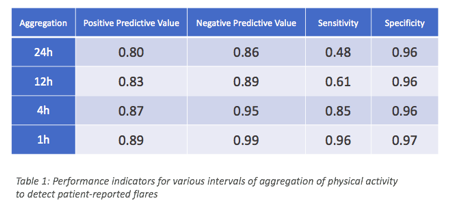Session Information
Session Type: ACR Poster Session B
Session Time: 9:00AM-11:00AM
Background/Purpose: A link between flares and physical activity would confirm the objective consequences of flares. In the ActConnect study of patients with RA or axSpA, the initial analyses made with traditional statistical tools on aggregated data found a low magnitude link between flares and physical activity(1). The objective of this reanalysis was to determine if applying Machine Learning technics (i.e., Big Data statistics) to this dataset, could lead to more accurate results about flares prediction.
Methods: In the ActConnect study, physical activity (steps) were collected through an activity tracker at the minute level, during 3 months for 170 patients, leading to 27 million information points that have been aggregated at the level of 24 hours (1). Patients also reported weekly their perceived flares. In this reanalysis, multi-class Bayesian classifications were performed to find a link between physical activity and flares / no flares states, using a Machine Learning software belonging to Orange (2). A normalization was performed to calibrate for each patient their pattern associated with no flares. As the data are sampled by minutes, models were designed using several aggregation intervals (24h, 12h, 4h, 1h) then trained randomly on 70% of data for each interval and tested on the remaining 30%. To evaluate the stability of the models, the complete analysis was done 10 times for each interval of aggregation. The performance of the models was evaluated using patient-reported flares (assessed weekly) as gold standard. Sensitivity, specificity and kappa were assessed.
Results: The modeling performance increased as the aggregation interval decreased. The best performance was evidenced for 1-hour interval (table 1). The increase in the agreement between the true classes and the predicted classes was also reflected in the substantial increase of the Kappa coefficient when the size of the aggregation intervals decreased (for 24 hours, kappa=0.51 [95% confidence interval 0.47, 0.56]; for 1 hour: kappa=0.90 [0.87, 0.92]).
1 – Jacquemin C et al. Ann Rheum Dis 2017 (suppl): EULAR congress, poster FRI0700.
2- Khiops software for data mining, PredicSis: https://khiops.predicsis.com
To cite this abstract in AMA style:
Guyard F, Gossec L, Leroy D, Lafargue T, Seiler M, Jacquemin C, Molto A, Sellam J, Foltz V, Gandjbakhch F, Hudry C, Mitrovic S, Fautrel B, Servy H. How Machine Learning Statistics Can Change the Game of Data Analysis in Rheumatology: The Example a Study with 170 Patients with Rheumatoid Arthritis (ra) or Axial Spondyloarthritis (axspa) [abstract]. Arthritis Rheumatol. 2017; 69 (suppl 10). https://acrabstracts.org/abstract/how-machine-learning-statistics-can-change-the-game-of-data-analysis-in-rheumatology-the-example-a-study-with-170-patients-with-rheumatoid-arthritis-ra-or-axial-spondyloarthritis-axspa/. Accessed .« Back to 2017 ACR/ARHP Annual Meeting
ACR Meeting Abstracts - https://acrabstracts.org/abstract/how-machine-learning-statistics-can-change-the-game-of-data-analysis-in-rheumatology-the-example-a-study-with-170-patients-with-rheumatoid-arthritis-ra-or-axial-spondyloarthritis-axspa/

